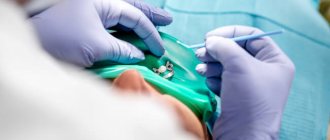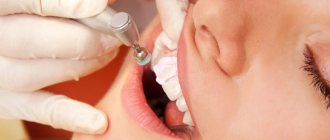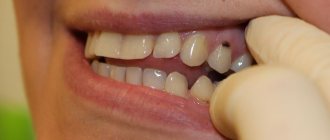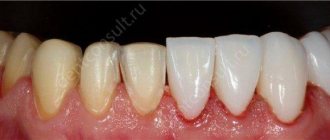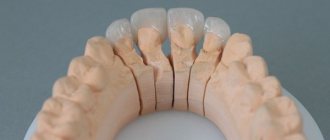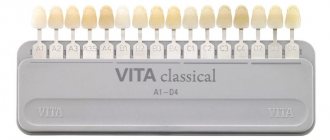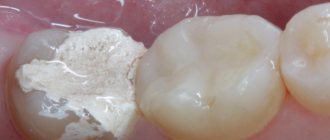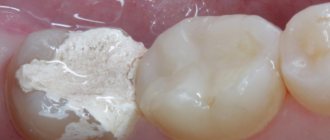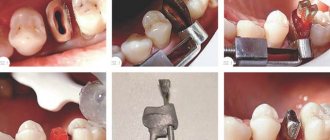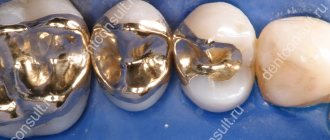5410
The possibilities of modern dentistry make it possible to save even a fairly badly damaged tooth, replacing the radical method of eliminating the problem, that is, removing the organ, with a more gentle procedure - its treatment through the use of fillings and inlays.
They allow you to return the tooth to its original functionality and qualitatively improve its aesthetics. And if everything is more or less clear with filling materials, then the use of inlays raises a number of questions among patients.
What kind of devices are these, what they are made of and how they are used - this will be discussed in this article.
General overview
Dental inlays are orthopedic micro-prosthetic structures that replace cavities in the crowns of damaged teeth.
As a result of the restoration, the organs acquire an anatomical shape and relief that is as close as possible to nature. In fact, this is another type of filling, but the only difference is that the production is carried out outside the patient’s mouth , and in the laboratory using a plaster cast.
This process allows you to get rid of shrinkage of the composite material , which inevitably occurs during classical filling.
Also, using the tab, it is possible to recreate an exact copy of the missing fragment of a destroyed tooth. All the tubercles on the surface of the product perfectly follow the contours of natural elements.
Microprostheses are characterized by a fairly strong macro and microstructure, which is resistant to abrasion. The products are installed already formed, while the filling material has a plastic consistency.
Inlays are a more progressive method of restoring the integrity of teeth. They provide longer and more stable operation compared to standard treatment.
What are the inlays made of?
Composite inlays are also easy to manufacture, quickly installed and allow you to accurately select a shade that matches the color of the tooth being restored.
Metal, composite material or ceramics are used to make microprostheses. They all have their own characteristics:
- Metal tabs are durable and easy to manufacture. They can serve for decades. But their aesthetic characteristics are low, so these designs are used only on teeth located deep in the mouth.
- Composite inlays are also easy to manufacture, quick to install, and allow you to accurately select a shade that matches the color of the tooth being restored. They are not as durable as metal ones, but if damaged they can be repaired right in the mouth.
- The most promising type of dental prosthetics with restorative inlays involves the use of ceramics as a manufacturing material. The professorial clinic “22nd Century” installs durable ceramic inlays with stable aesthetic properties. They are practically indistinguishable from the rest of the tooth surface.
Product advantages
The use of inlays for dental reconstruction has several undeniable advantages that make the use of this technique optimally preferable in comparison with other restoration methods:
- Precise connection . Fastening of the microprosthesis with the hard tissues of the coronal part is guaranteed by the ideal abutment of the walls of the structure.
- Tabs are more reliable and durable than, for example, a filling . To create it, materials are used (ceramics, metal alloys), which in all respects are comparable to enamel.
- High-quality reproduction of interdental segments, cusps, depressions, angular coronal zonal surfaces, taking into account the age and anatomy of natural units.
- Wear-resistant. This is possible due to the compliance of the load indicators with the requirements for this element.
- The material does not shrink . It is precisely because the filling tends to shrink over time that they often fall out, which never happens with inlays.
- Durable . The service life of structures significantly exceeds that of conventional fillings. The average duration of operation is 8-10 years.
- Convenient to install . During the placement of microprostheses, the patient does not need to constantly keep his mouth open so that saliva does not penetrate into the treated cavity. They fix quickly in a few minutes.
- Retains shade . Even after a long period of time, the tabs do not darken and cannot be stained with food coloring.
- They are the prevention of recurrent caries . Achieved due to the absence of shrinkage during operation, the ability to maintain original parameters and complete edge contact.
Flaws
The primary disadvantage of microprostheses is the impossibility of repairing them. If the material is partially destroyed or chipped, the tab must be replaced with a new one.
This is interesting: Types of clasps for dentures and what are they used for?
In addition, the design disadvantages include the following characteristics:
- high cost of installation (compared to conventional filling);
- other specialists are additionally involved in the process, for example, a technician;
- It takes more time to complete the entire complex of recovery manipulations.
It is also necessary to consider the professional factor - incorrect work of the doctor increases the likelihood of complications such as inflammation, tissue infection, poor adhesion of the inlay to the tissues.
Classification
There are several types of dental inlays, depending on the parameters, range of applications, and structural content.
Based on specific characteristics, all occlusal devices are classified according to three main criteria:
- restorative - devices that bring the chewing load applied to the periodontal fragments back to normal;
- loading - used as incomplete replacement of elements of the jaw row. Serve as support for bridge-like prosthetic structures;
- distributing – normalize mechanical pressure during fragmentary splinting of organs.
According to the topography of the defect
The main factor that negatively affects the position of the coronal area of the tooth is carious processes. That is why dividing the disease according to the principle of topography is important from the point of view of microprosthetics.
Within this classification, all pathologies are divided into 6 classes. This simplifies the specialist’s work. Having determined the class affiliation of the clinical situation, it is enough to simply identify the specifics of cavity formation, provide optimal conditions for attaching the lining and eliminating the risk of developing secondary caries.
Letter designations
Cavity diagnosis proceeds more easily using alphabetic symbols according to Boyanov’s method:
- O – cavity localized on the chewing surface;
- M – medial cavity;
- D – damage to the distal zone;
- MO is a complex clinical picture in which the cavity partially involves several surfaces. In this case – medial and chewing;
- MOD – lesions of all superficial segments.
By design
Based on the degree of damaging effects of caries manifestations on the coronal zone of the tooth, for high-quality replacement of elements of destroyed tissues, the following design options for inlays are distinguished:
- Inlay is a system fixed in the central region of the less invasive part of the organ, preserving the tubercular integrity of the relief;
- Onley is a prosthesis that affects the superficial slopes by applying overlays to the tubercles;
- Overlay is a device that, with its parameters, can completely cover internal slopes and uneven terrain with an overlay;
- Pinley – a device that is securely fixed inside the cavity using special pins located in hard dental areas.
During the production of such microprostheses, all tubercles are completely covered.On the frontal elements it is possible to manufacture a pin while maintaining the integrity of the cutting edge segment and vestibular relief. Visually, such structures resemble a half-crown pin model.
By material
To produce structures, dental technicians use the following materials:
- titanium alloys;
- gold;
- plastic - acrylic and semi-acrylic components, as well as derivatives of the nylon series;
- ceramics - made on the basis of zirconium, titanium oxides, standard porcelain composition;
- combined - include metal-composite compounds and ceramic-containing metal mixtures.
Indications and contraindications
Factors considered as a basis for inlay restoration include:
- The need to restore the structure and topography of heavily damaged units;
- Development of caries in circumstances where other restoration methods are ineffective;
- The presence of pathologies in hard tissues caused by excessive abrasion, mechanical defects, wedge-shaped anomalies and other factors;
- The need to create a base for installing a bridge;
- Using a tab as an element when creating and placing a splinting system.
Among the limitations that exclude the possibility or cast doubt on the feasibility of restoration using this technique are:
- Minor damage to dental tissue by caries;
- The destruction index of IROPZ is over 0.6;
- Changes in the natural structure of the tooth, leading to fragility;
- Location of cavity fragments in hard-to-reach areas.
Installation of ceramic inlays occurs in several stages
During the first visit, the patient’s teeth are prepared for filling: carious tissue is removed, a cavity is formed for the inlay, and an impression is taken.
This is interesting: Jaw bone atrophy - causes, symptoms, diagnosis and treatment
Using impressions, the dental laboratory first makes a model of the future filling, and then the ceramic insert itself. The process consists of layer-by-layer application of the material, periodic firing and subsequent polishing of the formed inlay.
During the second visit, the patient is fitted with and then glued into the prepared area, and the interface between the ceramic and the tooth surface is carefully polished.
Ceramic dental restoration is often the only opportunity to reconstruct a seriously damaged tooth in the most gentle way. Using ceramic inlays, you can increase the life of your teeth and avoid having to install crowns.
The creation of special adhesive compositions - the so-called adhesives - has brought dental restoration to a completely new level. Adhesives allow you to glue filling materials made from a wide variety of materials, including ceramic inlays, to the tooth surface.
The use of ceramic inlays, glued with adhesives, has become an ideal replacement for conventional fillings - especially for patients with severe tooth decay, when conventional filling is not possible, for example, when the pulp is damaged.
Restoration ONLAY.OVERLAY.INLAY
These are types of “fillings” made not in the oral cavity, but in the laboratory on a plaster model. Since production occurs outside the oral cavity, all the disadvantages inherent in the direct method disappear - the absence of stress shrinkage, the ideal, correct anatomical shape of the tooth, achieved by building based on the shape teeth of the opposite jaw. These onlays have an ideal, indelible macro and microstructure, where each cusp and fissure is built in the correct physiological place, which ultimately leads to the full chewing efficiency of the tooth. They have an ideal stable color and shine that does not disappear over time.
ONLAY OERLAY INLAY - can be made of reinforced composite material, ceramic and gold. Which material is better?
The best material in all respects except aesthetics is gold. Due to the plasticity of gold, the linings made from it are rolled over the edges of the tooth, enveloping them, thus strengthening and preventing microorganisms from penetrating into the thickness of the tooth. In the past, composite fillings replaced gold from dentistry, now gold is returning and for those patients who want the most long-term treatment results, “gold fillings” are the best treatment option.
In second place in terms of longevity are ceramic linings - their main trump card is ideal aesthetics and the shape of macro and micro relief, but unlike gold, ceramics do not have plasticity. But this disadvantage is compensated by the ideal manufacturing precision. Ceramic onlays currently make up 90% of all onlays manufactured in our clinic.
In the last place we placed occlusal linings made of composite reinforced material - in essence, this is the same filling material from which fillings in the oral cavity are made. But laboratory production allows us to talk about complete polymerization of the material using powerful laboratory lamps in a vacuum environment. And the shrinkage inherent in all composites is eliminated when the onlay is glued to the tooth. Of course, this type of onlay is much better than a direct filling, but due to the high price, which is close to ceramic onlays, we do not produce this type of restoration (composite occlusal onlays) in our clinic. Our alternative to fillings is OVERLAY, INLAY, ONLAY onlays made of gold and made of pressed ceramic E.Max
This is interesting: New generation dentures: removable and fixed
The process of manufacturing and installing inlays on a tooth
Dental prosthetics is performed in several stages:
- Initial consultation
. The doctor assesses the extent of destruction and draws up a recovery plan; - Hygienic teeth cleaning
if necessary; - Selection of the required shade
to match the enamel color; - Removal of tissues affected by caries
, if the destruction was caused by this disease; - Taking an individual impression
, according to which a microprosthesis will be made; - Closing the cavity with temporary material
for the waiting period; - Making an inlay
based on an individual impression in a dental laboratory; - Installation
of the inlay and its fixation using special dental cement.
Thus, a tooth can be restored in 2 visits to the clinic. The first visit is a consultation, treatment of caries and taking an impression, the second is the actual installation.
What are the alternatives?
If there is a volumetric lesion of the coronal part of the tooth, there are only four options for prosthetics. The first is the tabs themselves. The second is filling, but a large filling may not withstand the load, and there will be too few tooth walls for the composite material to adhere to, so it will be short-lived. The third method is to install a crown. But this option is an extreme option, when other methods are no longer effective. The fourth method is tooth restoration on a pin: a metal rod is installed inside the root, which serves as a support for restoring the coronal part (using an artificial crown or composite build-up). This option is cheaper, but less durable, and the pin can lead to root fracture.
Indications for installing inlay, onlay, overlay tabs
The use of ceramic and other onlay inlay overlay tabs is the best option in a number of cases:
- restoration of relief with a high percentage of destruction;
- treatment of caries in those clinical situations when other methods of therapy are not suitable;
- replacement of old and bulky fillings;
- treatment of hard tissue pathologies not related to caries;
- creation of supports for prosthetics and the formation of bridge structures;
- creation of splinting systems for the treatment of periodontal lesions.
The use of overlays and inlays is not advisable for mild carious lesions or, conversely, for significant destruction of the crown, for violations of the structural composition of tooth tissues, and for difficult access to cavity fragments.
Tabs lifespan
How long the inlays will last depends largely on the initial condition of the tooth. If a sufficient number of supports have been preserved to fix the prosthesis (that is, not only the base of the cavity, but also the walls of the tooth), its installation was carried out professionally, then the composite inlay will last from 3-4 years, ceramic or zirconium - from 10 years or more. Proper care of the restored tooth is also important (it is necessary to prevent the development of caries, since in this case the inlay will have to be removed and redone).
Regular care and periodic preventive examinations at the dentist will help extend the service life, the purpose of which is to assess the condition of the tooth and the quality of the fit of the prosthesis.
Service life
The service life of each type of orthopedic inlay is primarily determined by the material used in their manufacture.
The strongest and most durable of them are gold products. With proper installation and careful handling, the average service life is 8-10 years.
Ceramic structures also have good performance in this regard. The service life is slightly lower than gold, about 6 years.
The following can affect the duration of operation, or rather reduce it:
- unprofessional actions of a specialist during the creation and installation of tabs;
- changes in the structure of bone tissue;
- ignoring or insufficient compliance by the patient with recommendations regarding care, daily hygiene and operation of structures.
Watch the video to see the process of installing the Onlay tab.
Prices
The average cost of a tab is determined by the material from which it is made.
Analyzing the pricing policy of many dental clinics that provide services for the restoration of hard dental tissues with microprostheses, the cost looks something like this:
| Material | Average cost in thousand rubles. (for 1 piece) |
| metal | From 8 |
| plastic | From 6.5 |
| ceramic | From 17 |
| combined | From 12 |
Reviews
Restoration of damaged teeth with inlays is classified by dentists as the most gentle treatment method. Despite the high cost, its effectiveness is high if there are indications for it.
If you have experience with such treatment and would like to express your opinion on its effectiveness and feasibility, please share your feedback in the comments to this article.
Sources:
- https://zubovv.ru/protezirovanie/nesemnyie-p/vkladki/inlay-onlay-overlay.html
- https://smile-at-once.ru/uslugi/vkladki.html
- https://www.vash-dentist.ru/protezirovanie/nesemnyie-p/vkladki/inlay-onlay-overlay.html
- https://doctorhollywood.ru/keramicheskie-vkladk
- https://galadent.ru/protezirovanie/vkladkikeramicheskieonlayinlayoverlay

